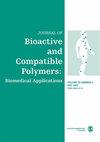交联右布洛芬纳米凝胶的制备与评估
IF 2.2
4区 生物学
Q3 BIOTECHNOLOGY & APPLIED MICROBIOLOGY
引用次数: 0
摘要
本研究旨在设计和开发一种琼脂糖基聚合物纳米凝胶网络系统,用于提高亲脂性药物右布洛芬的溶解度。在过硫酸铵(APS)作为引发剂和 N,N'-亚甲基双丙烯酰胺(MBA)作为交联剂的存在下,琼脂糖与 2-丙烯酰胺基-2-甲基丙烷磺酸(AMPS)交联,通过自由基聚合合成聚合物纳米凝胶。对所制备的聚合物纳米凝胶进行了全面的表征,包括傅立叶变换红外光谱(FTIR)、粒度分析、扫描电子显微镜(SEM)、差示扫描量热仪(DSC)、热重分析(TGA)、粉末 X 射线衍射(PXRD)和溶胀研究,以确认制备出了稳定的聚合物纳米凝胶体系。傅立叶变换红外光谱分析结果表明,琼脂糖与 AMPS 发生了化学交联,并证实 AMPS 链成功地插入了琼脂糖骨架。粒度分析表明,纳米凝胶的直径为 168 nm,Zeta 电位为 -9.91 mV,保证了纳米凝胶系统的稳定性。扫描电子显微镜图像显示了一个高度多孔的表面。DSC 和 TGA 结果表明,与单个成分相比,网络系统的热稳定性更高。膨胀研究表明,与 pH 值为 1.2 的酸性缓冲液相比,聚合物纳米凝胶在 pH 值为 6.8 的磷酸盐缓冲液中的膨胀率更高。在聚合物纳米凝胶系统中有效地负载了右布洛芬,其包载效率高达 80%。与纯药物相比,加入聚合物纳米凝胶制剂的药物溶解度有所提高。通过体外药物释放和药物释放动力学模型评估了该系统的重现性。毒性研究证实了制剂的有效性,表明所开发的聚合物纳米凝胶具有出色的理化特性、更高的溶解度和最小的口服毒性,是输送亲脂性药物的理想选择。本文章由计算机程序翻译,如有差异,请以英文原文为准。
Fabrication and evaluation of cross-linked nanogels of Dexibuprofen
The objective of this study was to design and develop an Agarose-based polymeric nanogel network system for solubility enhancement of a lipophilic drug, Dexibuprofen. Polymeric nanogels were synthesized through free radical polymerization where Agarose was cross-linked with 2-Acrylamido-2-methylpropane sulfonic acid (AMPS) in the presence of ammonium persulfate (APS) as an initiator and N, N’-Methylenebisacrylamide (MBA) as crosslinking agent. The resulting polymeric nanogels underwent a comprehensive characterization process including Fourier transform infrared (FTIR), particle size analysis, scanning electron microscopy (SEM), differential scanning calorimetry (DSC), thermal gravimetric analysis (TGA), powder X-ray diffraction (PXRD), and swelling studies to confirm the preparation of a stable polymeric nanogel system. FTIR spectral findings revealed that Agarose was chemically cross-linked with AMPS and confirmed the successful insertion of AMPS chains on the Agarose backbone. Particle size analysis revealed a diameter of 168 nm with a zeta potential of −9.91 mV, providing assurance of a stable polymeric nanogel system. SEM images depicted a highly porous surface. DSC and TGA results showed a more thermally stable network system than individual ingredients. Swelling studies revealed an increased swelling ratio of polymeric nanogels at phosphate buffer of pH 6.8 than acidic buffer of pH 1.2. Dexibuprofen was efficiently loaded into a polymeric nanogel system with a high entrapment efficiency of up to 80%. The solubility of the drug was enhanced when introduced to a polymeric nanogel formulation when compared to pure drug. The system reproducibility was evaluated through in vitro drug release and kinetic modeling of drug release. Toxicity studies confirmed the formulation’s effectiveness, showcasing the developed polymeric nanogels as a promising option for delivering lipophilic drugs, with outstanding physicochemical properties, improved solubility, and minimal oral toxicity.
求助全文
通过发布文献求助,成功后即可免费获取论文全文。
去求助
来源期刊

Journal of Bioactive and Compatible Polymers
工程技术-材料科学:生物材料
CiteScore
3.50
自引率
0.00%
发文量
27
审稿时长
2 months
期刊介绍:
The use and importance of biomedical polymers, especially in pharmacology, is growing rapidly. The Journal of Bioactive and Compatible Polymers is a fully peer-reviewed scholarly journal that provides biomedical polymer scientists and researchers with new information on important advances in this field. Examples of specific areas of interest to the journal include: polymeric drugs and drug design; polymeric functionalization and structures related to biological activity or compatibility; natural polymer modification to achieve specific biological activity or compatibility; enzyme modelling by polymers; membranes for biological use; liposome stabilization and cell modeling. This journal is a member of the Committee on Publication Ethics (COPE).
 求助内容:
求助内容: 应助结果提醒方式:
应助结果提醒方式:


